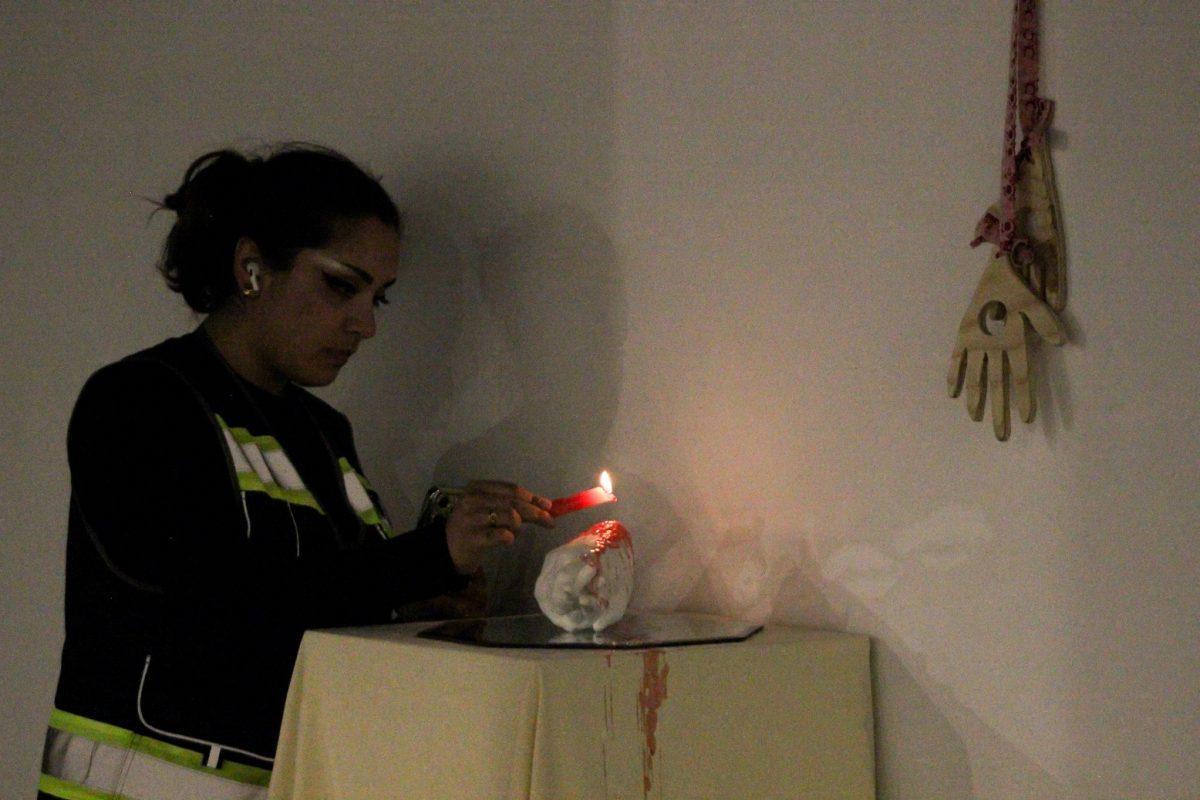Wood, wires, rope and projectors, and an array of art materials litter the floor of the SP/N gallery. The disorder in this space sheds insight into the creative process of graduate students’ art projects, part of the “Small Talk” exhibit.
“Small Talk” is a multimedia installation project created as part of a class — VPAS 6391, Creativity Visual Arts Workshop: Post-Studio Arts — which is taught by professors and exhibit curators SV Randall and Laura Kim. As part of the exhibit, UTD graduate students’ preliminary art projects will be displayed at the SP/N Gallery through April 26, highlighting their creative processes from start to finish. The gallery is their art studio, giving visitors the chance to tour the students’ work before completion, contribute their own ideas and better understand the decisions and process behind preparing different mediums for the public eye. Kim said the name “Small Talk” is a reference to the impact of gallery conversations in driving discourse on art.
“When artists make [their] work, it’s always in collaboration with other artists, the community or strangers that visit the exhibition,” Kim said. “Within gallery settings, you meet random people who are interested in your work [and] it’s a very important driving factor of building community.”
Anisha Chaudhary, an ATEC graduate, is constructing a sculpture titled “Reflection of Choice,” displaying her personal journey with her secrets, insecurities and memories in a cage-like structure using materials like plywood, mirrors and plaster to protect a hidden object. She said mirrors are a literal representation of inner reflection and can selectively choose what is shared with viewers, hence its title.
“I’m trying to find empowerment through selective sharing and underscoring the importance of my choice about what I want to talk [about, like] experiences of trauma or sexual abuse,” Chaudhary said.
Chaudhary said she had the idea for this sculpture since 2022 after visiting an exhibit in 500x, a gallery in Dallas, which addressed the topic of trauma. Although she has had this idea for the past two years, she initially felt shame after writing a proposal for the project. The creation processes was an emotional endeavor, which she specifically presented through hands made of plaster to show forceful control.
“I think that’s just the grief that you feel about the traumatic experience,” Chaudhary said. “But after being open about it and having people interested in it and seeing that validation, I am taking back that experience and letting people know it belongs to me.”
Parul Bhatia, an ATEC graduate student, is creating a performative art piece using dances, and rituals performed by her partner Maulin Agrawal and video footage of nature and palaces to explore the art of Tantra. Tantra is a tradition of yoga with the goal of making the practitioner more grounded, using a range of practices that are often misconstrued as inherently sexual. Agrawal said Tantra is a principle of Hinduism that many people associate with “naked sex orgies in ancient temples.” However, those that do involve sex in Tantric meditations, like Tibetan Buddhism, are rare.
“[The art piece is] very spiritually charged,” Agrawal, a VPAS graduate, said. “It’s a depiction of ritual and dance so that [viewers] can appreciate the culture and learn something from it and not just stick with generalizations.”
The interest in Tantra started as a way for Bhatia to meditate and cultivate bodily awareness using mantra, mudra — which relate to hand positions, and Yantra — which are geometric designs that invoke deities. As an Odissi, or Indian classical dance performer, Bhatia’s dance guru Rekha Tandon introduced her to the practice of Tantra.
“[Tandon] introduced me to the standard practice where before you start your dance, you center yourself,” Bhatia said. “You ground yourself and you invoke the divine deity. I found that intriguing and grounding.”
Brenda Vega Mora, a Ph.D. student, said her piece is an immersive installation where onlookers can see altered photographs of the artist, prompting viewers to think about their dependence on technology. Her installation is “Disappearing Self Act II,” a continuation of her earlier work titled “Disappearing Self,” and seeks to imagine a world without technology.
“We’re gonna have a different experience with time and with our bodies, and other key aspects of my work is self-representation,” Mora said. “So I am using my body as a place of research.”
Red and purple light is used in her installation, as both light colors alter photographs based on how much they are exposed to them. Red light is used to develop photographic film with an unaltered color palette, whereas longer exposure to purple light adds a bluish tone. This will yield a constantly changing image and experience for the duration of the exhibit.
“I think it’s gonna be very interesting because we’re taking over the SP/N Gallery for a month,” Mora said. “[It’s] a work in progress of 19 people, and in my case, I’m going to continually change [my art] and see how I feel that week and how [I’d] like show my [art] for the closing event.”
Maryam Takaloubighash, a Ph.D. student, will have an installation piece consisting of laser-cut plywood in the shape of her body at different scales to show how women grow up and view themselves in society. The idea for her project came from a Persian painting style in which people are depicted smaller or larger depending on their social status.
“I started playing with this idea and showed that if you depict me as small in a society, I make my body [take up] less space,” Takaloubighash said.







